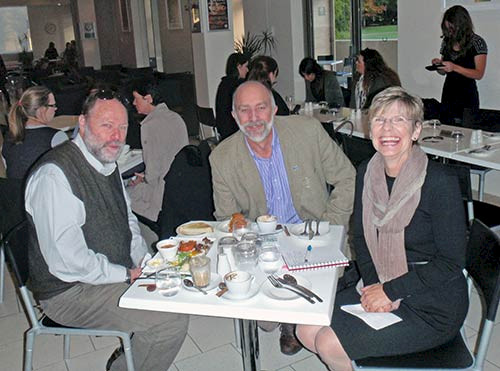Swanlands: Western Australia estuaries
Bill Dennison ·I had breakfast with Malcolm Robb, Western Australia Department of Water, and Professor Lyn Beazley, Western Australia Chief Scientist. We talked about a wide range of issues associated with science applications and education. Lyn is a vibrant and personable scientist who clearly advocates for science in Western Australia. She spoke about getting microscopes into schools, about empowering citizen scientists, and about encouraging scientists to share data and communicate their results to the broader community.

The National Estuaries Network Science Symposium, held at the University Club of Western Australia, had a series of estuary talks. A diversity of approaches (experimental, observational, lab and field, modeling) to study the biology, chemistry and physics of estuaries was presented from graduate students, postdocs, lecturers, professors and resource managers. In my summary of the symposium, I made four recommendations. The first three recommendations were 1) synthesis, 2) synthesis, 3) synthesis and my final recommendation was to communicate this synthesis widely.

Swanland: the estuaries and coastal lagoons of South-western Australia, a wonderful book, stimulated by Ernest Hodgkins and written by Dr. Anne Brearley, is the definitive book on Western Australia estuaries. It is richly illustrated with maps and photographs, and has historical perspectives and ecological summaries of each estuary. I felt bereft without my copy with me, as it is a large, heavy book, and I talked with Anne about generating an ebook version.
One of the things that I enjoyed was the common names of Western Australia fishes, with names like 'Western Gobbleguts, Weeping Toadfish (or 'blowies'), Sandy Sprat, and Spotted Hardyhead. Another thing that I enjoyed was the prolific use of conceptual diagrams using Integration and Application Network symbol libraries (8/19 talks used conceptual diagrams), the excellent graphics like Chari Pattiaratchi's, and the wonderful photographs like Marion Cambridge's historical and recent underwater seagrass photos. Lyn Beazley used paintings and beautiful photographs to illustrate the history and science of the Swan River.
At the end of the day, I provided one sentence summaries of each of the talks. Professor Lyn Beazley, Western Australia Chief Scientist: Scientists need to Do, Translate and Communicate their results. Bill Dennison, University of Maryland Center for Environmental Science: Innovations in scientific synthesis, communication, reporting and governance can be used to solve environmental problems. Professor Chari Pattiaratchi, University. of Western Australia: Seiches, tides and pressure systems cannot mix Swan River bottom waters. Malcolm Robb, Western Australia, Department of Water: Irrigation and cows*** influence Western Australia estuary report cards. Dr. Kath McMahon, Edith Cowan University: Seagrass torture chambers show temperature and carbon dioxide impacts (or Pearl makes Kath a lab rat). Dr. Fiona Valesini, Murdoch University: Stats show that environmental features create habitats and associated fish assemblages. Dr. Mads Thomsen, from Denmark: Seaweeds are more important than feral snails or temperature in screwing up seagrasses. James Tweedley, Murdoch University: Broke Inlet was not broken, until Murdoch fisheries scientists removed 83,000 fish. Dr. Matt Hipsey, University of Western Australia: Matt's model scorecard leads to community modeling approach. Dr. Kevin Petrone, Commonwealth Science and Industry Research Organisation: Amino acids from urban areas and humics from rural areas are sexy organic matter from gutless gray soils. Leticia Vilhena, University of Western Australia: Phytoplankton modeling in the Swan estuary indicates that turbidity and dissolved organic matters reduces phytoplankton. Lauren Veale, Murdoch University: A sea change in fish after 15 years, with similar fish but different abundances. Alice Gedaria, University of Western Australia: There is a lot of little stuff in Swan River including bacteria, viruses and picoplankton. Dr. Anne Brearley, University of Western Australia and author of Swanland: Blackwood Estuary 35 years on indicates less worms and variable bivalves. Chris Gunby, Western Australia Department of Water: Professor Gunby doesn't need a squeezy ball, rather his top ten tips provide wise advice. Dr. Marion Cambridge, University of Western Australia: Albany Harbours case study shows that oligotrophic seagrasses are susceptible to eutrophication but can recover. Gary Chaney, Edith Cowan University: Black swans eat 5-25% of Halophila and Ruppia productivity in shallow hotspots. Dr. Chris Hallett, Murdoch University: Fish indices other than dead fish can be developed for Western Australia estuaries. Greg Jenkins, Challenger Institute of Technology: Black bream restocking successful in Blackwood River.
My overall summary for Western Australia estuarine science and management was the following: Knowledge about Western Australia estuaries is accumulating rapidly. Western Australia estuaries are being managed as well as anywhere in the world, which is still not good enough. We need to continue to strive to achieve better estuarine management in Western Australia and the world.
About the author
Bill Dennison

Dr. Bill Dennison is a Professor of Marine Science and Vice President for Science Application at the University of Maryland Center for Environmental Science.

